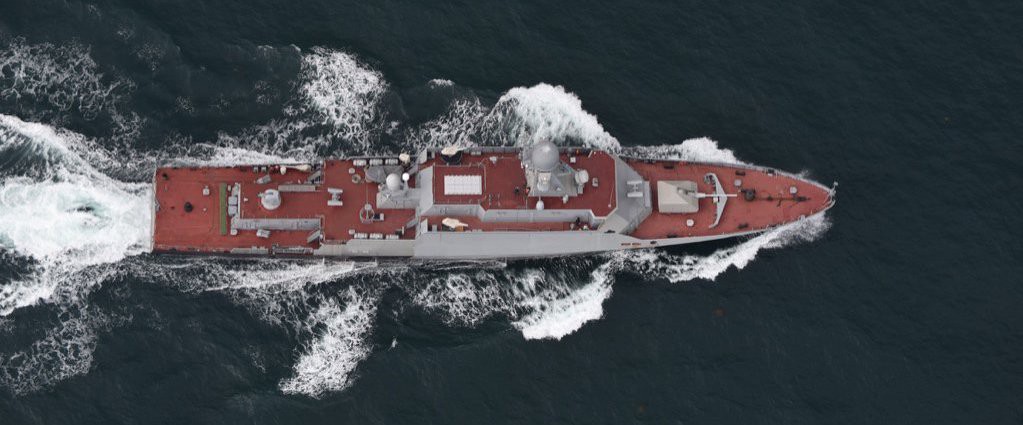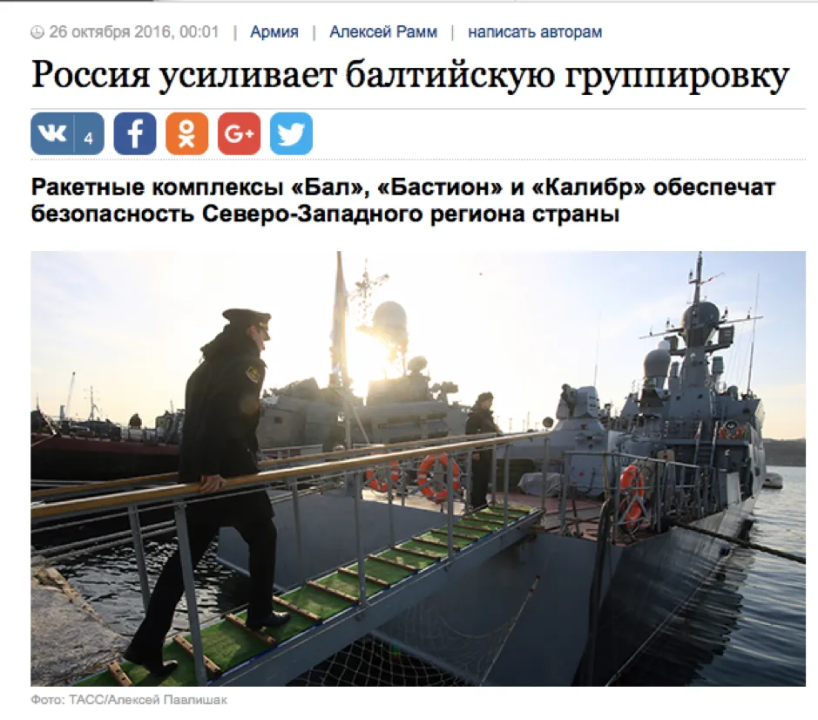Gunboat Diplomacy
What lies behind the transfer of Russia’s long-range cruise missile ships to the Baltic? And is it the game-changer that analysts in Russia and the West seem to think?
Gunboat Diplomacy
Share this story

BANNER: RFS Zelenyy Dol in the North Sea, 23 October 2016. (Source: Royal Netherlands Navy)
Read Part 1 of DFRLab’s investigation into unexpected journey of Russian vessel in the Baltic Sea.
It’s confirmed: two Russian Buyan-M class corvettes of the Black Sea Fleet, armed with Kalibr-NK long-range cruise missiles, have entered the Baltic Sea, despite the fact that the Russian government said they were meant to stay in the Mediterranean.
As we reported on Sunday, the RFS Zelenyy Dol and Serpukhov have made a long, and undeclared, sea voyage from the Black Sea all the way around the European mainland to the gates of the Baltic.
Late on Tuesday, Swedish newspaper Aftonbladet quoted a press officer of the Swedish defense forces as confirming that the two ships had entered the Great Belt through Denmark:

“I’ve been in contact with our marine tactical staff and they confirm that two corvettes from Russia are entering the Great Belt just now,” says Kristina Åstrand Bohman, duty press officer for the armed forces, on Tuesday evening.
She also confirms that it concerns Buyan-M type vessels.
The transit was shadowed by the Danish Navy. Among others, a number of patrol boats and the Danish Navy’s most powerful frigate, the HDMS Niels Juel.
Based on that information, online ship-watchers tracked the Niels Juel through the Great Belt into the night:

By 10:00 UTC on 26 October, the Niels Juel was reportedly back in harbor:

The ships’ undeclared move to the Baltic has raised concerns around the shores of the sea. Aftonbladet interviewed two commentators on the implications. The first, an unnamed “source in the Navy”, was quoted as saying:
“This could be a game-changer for the Baltic Sea region. Suddenly we have ships armed with cruise missiles that can be armed with tactical nuclear warheads in our region.”
The second, Tom Ries of the National Defense College, agreed on the scale of the change:
“Politically, it’s startling, and a very strong mark. Putin is moving up a long-range missile which can carry a nuclear warhead and he’s placing it right in the middle of the Nordics. It’s a clear show of force. At the same time, it also changes the military balance in the Baltic Sea region.”
Separately, Danish daily Jyllands-Posten quoted the defense spokesman of the Social Democrat party, Henrik Dam Kristensen, as saying, “I’m not worried by a single event [the entry of the ships into the Baltic], but I am worried about what’s happening in the Baltic Sea, and the way in which Putin is behaving in the Baltic, and especially in Syria.”
Meanwhile, spokesman for the Latvian Defense Ministry, Kaspars Galkins, was widely quoted as calling the move a “show of force to intimidate and pressure NATO. The goal of the show of force is psychological influence.”
“Suddenly we have ships armed with cruise missiles that can be armed with tactical nuclear warheads in our region.”
To the North, Swedish Radio quoted Defense Minister Peter Hultqvist as telling the TT news wire that “This is still worrying and does nothing to contribute to the easing of tensions in our region. It affects all the countries around the Baltic Sea.”
The view from Russia: Flip-Flop Messaging
In Moscow, Russian Ministry of Defense has still not commented on the move. Its most recent statement on the two ships dates back to 5 October, the day after they left Sevastopol (officially their home port), with the claim that they were to be attached to Russia’s naval squadron in the Mediterranean:

However, on 26 October contrary to the Russian Defense Ministry’s claims, the Izvestia newspaper quoted “an informed source in the Russian Defense Ministry” as confirming that the two ships are indeed being transferred to the Baltic Fleet, and that they will serve as the core of “a new division of Buyan-M small missile ships armed with Kalibr cruise missiles.”
Moreover, the newspaper reported that the transfer was part of a larger effort to reinforce Russia’s Baltic Sea enclave of Kaliningrad with shore-based “Bal” and “Bastion” coastal defense missiles:

According to the report:
A coastal-defense missile regiment in Kaliningrad was recently equipped with modern Bal missiles;
- Kaliningrad will be reinforced with a missile brigade armed with Bastion and Bal coastal missile systems;
- Three more Buyan-Ms have been ordered for delivery in the 2020 time frame, and are being constructed with specially reinforced hulls for icy conditions;
- The division will be formed around the Zelenyy Dol and Serpukhov;
- The Baltic Fleet will be reinforced with a new division of Buyan-M class small missile corvettes;
- The expectation is that this will form the core of a new brigade.
An analyst interviewed by the paper, Ruslan Pukhov, was quoted as saying that the movement of the ships and missiles would constitute an “asymmetric response to the increased presence of NATO member states’ military contingents in the Baltic States”. Pukhov is the director of the Russian Centre for Strategic and Technological Analysis, which in turn manages the military blog bmpd.livejournal.com, a generally reliable commentator on Russian military issues.
Pukhov’s comment is worth citing in full:
“The new coastal defense complexes in the Kaliningrad district and the small missile ships in the Baltic will have practically the whole Baltic Sea in range, including, most importantly, the military infrastructure which NATO is creating in the Baltic States. Instead of creating a numerous and expensive military formation, Russia is creating a compact group of ships and missiles, small in number, but armed with serious strike capabilities.
“Nonetheless, this scheme also has definite technical complexities. Until the Buyan-M ships are armed with the Pantsir-M naval surface-to-air missile, they will be vulnerable to air strikes, so the places from which they could launch the Kalibrs would have to be covered by Russian fighter aircraft and anti-aircraft systems. That materially limits the areas from which they could be used in combat.”
Even before the presence of the ships in the Baltic was confirmed, an article in online outlet business-online.ru analyzed their apparent transfer to the Baltic Fleet, and also interpreted it as a response to NATO.
In this case, two analysts were interviewed. The first was Prokhor Tebin, who concluded:
“If the Buyan-M ships are really going to join the Baltic Fleet, then evidently the military leadership will be working on the assumption that Russia needs long-range cruise missiles in the Baltic to parry current threats.”
The second, Dmitry Glukhov, concurred:
“Ships like these are needed everywhere, especially right now, including in the Baltic. They’re potentially capable of “sweeping” the whole of Europe. That is, the Baltic Fleet is again taking on its forgotten quality as a regional strategic force, an almost irresistible one. Together with the Iskander-M missile complexes in the Kaliningrad region, their presence could entirely cool down the hot heads of the leaders of certain new NATO member states. Let’s not forget, too, the elements of the U.S. missile-defense system in Poland […] In that way, the transfer of the Black Sea Fleet’s two small missile ships with 16 Kalibr missiles on board is an answer to NATO’s military preparations in the region.”
Bubble trouble
To what extent do these various comments express a new military reality in the Baltic?
The addition of two Kalibr-armed ships would be a significant upgrade to the Baltic Fleet’s arsenal; as we have already reported, its current surface combatants do not boast any weapons of a comparable range.
It is not the first time that Kalibr-armed ships have been seen in the Baltic. Russia’s new line of frigates, the Admiral Grigorovich class, are also equipped with the cruise missiles, and are the work of the Yantar shipyard in Kaliningrad.
However, of the three ships of the class currently in service, the Admiral Grigorovich joined the Black Sea Fleet on 9 June, the Admiral Essen reportedly left Baltiysk on 16 October to head to Sevastopol, and the Admiral Makarov is currently reported in the Barents Sea for weapons testing. All three are officially meant to join the Black Sea Fleet, and while this is no indication that they will actually go there, the addition of Kalibr-armed corvettes to the Baltic Fleet would nevertheless represent the first permanent stationing of such missiles in the Baltic.
What’s new is the comment in Izvestia that this is part of a larger package.
The claim that Russia has ordered three more Buyan-M ships for the Baltic Fleet appears to be partially corroborated by earlier statements. According to a press release from the Russian MoD on 7 September, Deputy Defence Minister Yuriy Borisov signed contracts for a number of new vessels, including three Buyan-M corvettes valued at 27 billion roubles. While there was no indication at the time that the new ships would be equipped for icy conditions or assigned to the Baltic, it is possible that they will.

The claim that coastal defense forces are to be enlarged and upgraded also appears plausible. Rumors to that effect have been circulating since at least March this year, when Russian outlet Svobodnaya Pressa reported that there were “reasons to suppose” that the Bastion system would be deployed to Kaliningrad “in the nearest future”. Kaliningrad is currently home to the 25th Independent Coastal Missile Regiment (unit number 39108), located in Donskoye (54.9446959N 19.9679947E):
As of July 2016, specialist outlets were reporting that Kaliningrad was already hosting Bal anti-ship missiles, although the unit identity remained unconfirmed.
Such deployments would be consistent with Russia’s earlier decision to site S-400 surface-to-air missiles in Kaliningrad, creating an Anti-Access Area Denial (A2/AD) zone over the eastern Baltic.
The range of the Bastion missile (NATO reporting name “Stooge”) is believed to be up to 300km; the range of the Bal (NATO name “Sennight”) up to 260km. The range of the S-400 surface-to-air missile is reportedly up to 250km. The Kalibr missile itself, meanwhile, has a reported range of up to 350km against ships.
This combination of Kalibr-armed ships with anti-ship and anti-air missiles would therefore strengthen Russia’s existing A2/AD bubble over the eastern Baltic, creating a zone some 250–350km deep in which the movement of other countries’ air and sea forces would be seriously constrained, and a much wider radius (up to 2,600 km, depending on sources) in which the Kalibr missiles could strike land targets.
The arrival of the Serpukhov and Zelenyy Dol in the Baltic is not, perhaps, a game-changer in itself. But it certainly enlarges the bubble of trouble over Kaliningrad which is challenging NATO’s presence.
Ben Nimmo is the Senior Fellow for Information Defense in the Atlantic Council’s DFRLab. Maks Czuperski is Strategic Communications Advisor to the President of the Atlantic Council and leads the Atlantic Council’s DFRLab.

